#1880s extant garment
Text

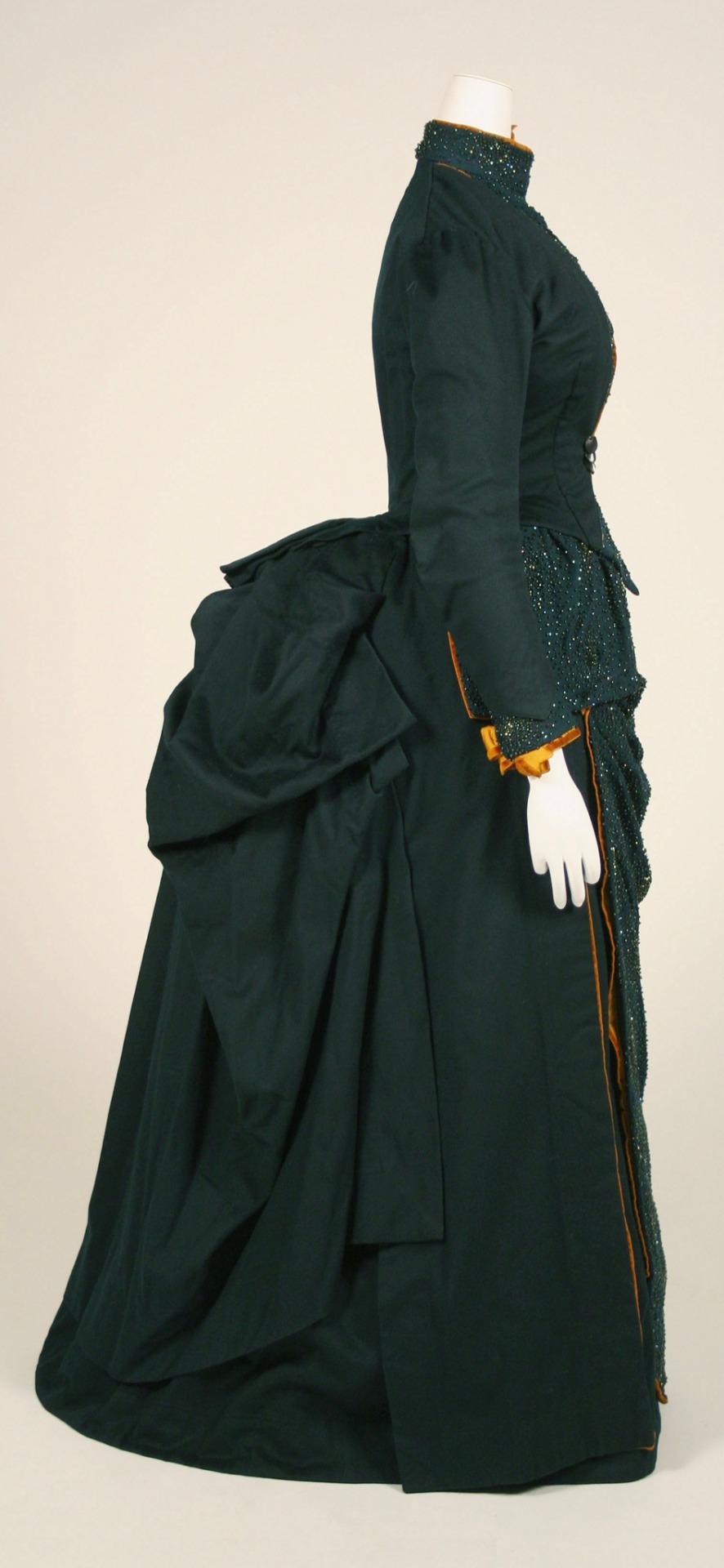

Green wool dress, ca. 1887, American.
Designed by Catherine Donovan.
Met Museum.
#Catherine Donovan#green#womenswear#extant garments#dress#silk#wool#19th century#met museum#usa#1880s#1887#1880s dress#1880s usa#1880s extant garment
1K notes
·
View notes
Text

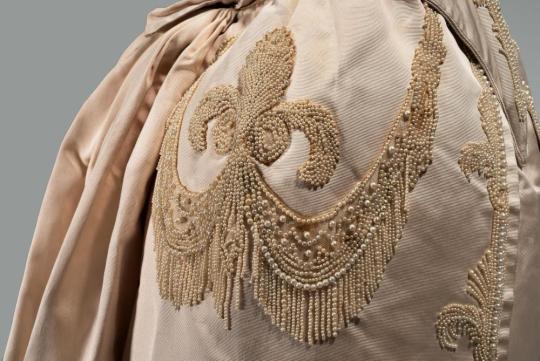
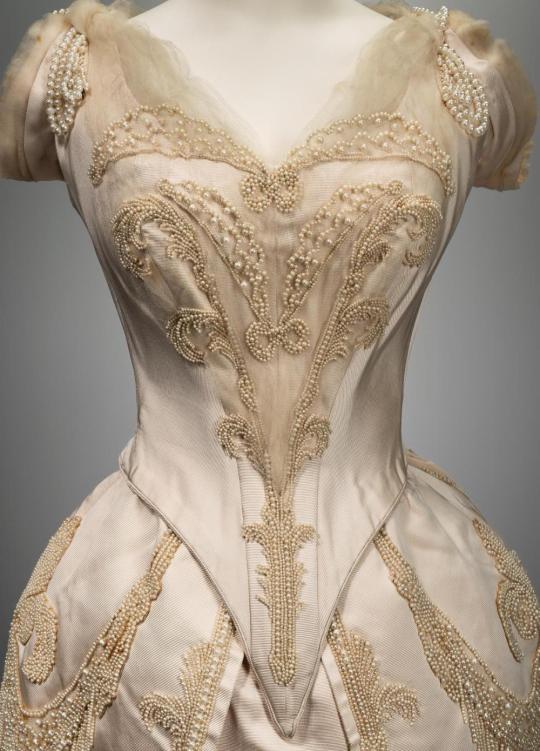
Evening dress by the House of Worth ca. 1880
From MFA Boston
2K notes
·
View notes
Photo


Walking Dress
Attr. to Charles Fredrick Worth
1876-1882
The MET (Accession Number: 2009.300.6291a, b)
#walking dress#fashion history#historical fashion#charles fredrick worth#1870s#1880s#house of worth#19th century#bustle era#off white#cotton#linen#lace#france#the met#me seeing a photo of someone wearing an extant garment:#oh the followers are going to have THOUGHTS#at first i was like is this really a walking dress#and then i was like if you can afford Worth#your walking dress is probably going to look like this yeah
146 notes
·
View notes
Note
the gilded age costuming is interesting in that they deliberately take inspiration from later designs for bertha and gladys to emphasise the “nouveau riche” while the old money characters will be clothed in more historically accurate fashions (some are even direct replicas of paintings/extant garments)
I do understand the urge to do that, and I know it's approach with a lot of historical costuming, but personally I dislike that approach. I think it misunderstands the point of fashion in Victorian society. Today we think of the most fashionable people to be very forward thinking in their fashion and for formal clothing to be most fashionable. Red carpet is often treated as fashion event. However, this was not the case in Victorian society. Fashion was social decorum, it was a requirement to participate in high society. Or rather it was requirement to participate in society at all. Even workers adhered to the fashionable silhouette, while working. Here's for example factory workers from mid 1890s with perfectly fashionable silhouettes with the big sleeves and all.

I think it's quite backwards to think nouveau rich would be experimenting with futuristic fashion. It's unthinkable they wouldn't adhere to the fashionable silhouette for high society events especially. They were the ones trying to establish themselves as part of high society, so they would be the ones most religiously following the fashionable silhouettes and styles. This is why tea gowns were much more experimental, and why the counter cultural Aesthetic style, which rejected the Victorian silhouette, could first entered high society through tea gowns. Tea gowns were worn in more intimate society gatherings (afternoon tea with neighbors and friends), so there was more room to experiment with new counter cultural styles. Tea gowns in 1880s had many of the elements that would become fashionable in 1890s, looser fit in bodice, natural form bustle and even balloon sleeves. Some British middle class/upper middle class women would dress in Aesthetic dress during 1880s in public society events, but they were not part of the upper echelon of high societies and no one dressed that way in high society evening events. The old money rich people also had more room to experiment with more unconventional fashion than nouveau rich, since their position in the exclusive high society was so much more secure, even if they were not as respectable (and adhering to the fashion ideals was about respectability) as expected of high society, their connections and status protected them from consequences. Money was not enough to secure your status, you needed connections.
107 notes
·
View notes
Note
I'm new to the historical costuming and historybounding community and I noticed something odd and I wnated to know your opinion about it.
1850s/60s clothes are essentially nonexistent in the community at large. Every now and again, someone will make a Little Women inspired something, but that's it. No one seems to dislike this period, but no one seems to love it either?
Which confuses me so much because I would have assumed it to be one of the most popular styles, the way that the 1890s are in actuality.
Oh yeah, you're absolutely right! It IS rather underrepresented.
My main thought is that it's less practical for potential everyday modern wear than the later 19th century, and therefore less popular. Hoop skirts are marvelous, and not as huge or unwieldy as people like to think, but they're still not terribly practical for most people's lives nowadays. I adore the late 60s/early 70s elliptical skirt and bustle styles, but taking up so much space on the train would get me intense dirty looks at minimum. So I tend to aim a bit later- Natural Form or 1880s/90s transitional.
(Though I admit, it IS rather frustrating that almost every other daily wear historical costumer does 1890s/early 1900s. I want tips for styling a blouse so it looks less Edwardian Shirtwaist and more 1879 Blouse Waist, damnit! I can look at ads and photos and extant garments and fashion plates myself, but I'd love to have living people to compare notes with.)
I can recommend two bloggers who do more 1860s stuff, though: The Quintessential Clothes-Pen (Quinn Burgess) and Plaid Petticoats (Raven Stern). They do other eras as well, but it's not as much of an 1890s washout as popular costubers sometimes tend to be- with no hate intended to those people; that's just what they like to make! Neither of the bloggers I recommended are Everyday Victorian Clothing people, so that might contribute to their era flexibility.
Best of luck in finding your 1860s dream content!
(Also, if you DO want some more practical everyday 1860s, you could try looking at 1867-69; there was a brief A-line skirt moment there that everyone forgets about, but which would be less space-consuming than hoops.)
122 notes
·
View notes
Text
fem!William cosplay
In honor of sherliam week 2023, I'm gonna start posting about my plans for a hopefully historically-accurate cosplay of William! :D
i'm planning on designing 4 outfits: professor, noblewoman day wear, noblewoman evening party wear, and traveling wear. I'm probably going to be actually making one of the first two or both. I could also throw in a teagown, loc outfit (though i honestly think it would just be the same as canon anyways?), sleepwear, specific design for undergarments, etc, but we'll see if i'm still interested in that later
when I first came up with the idea sometime in july or august, because i am such a historical costume girly, i was like, so i would do a male one except i know that i would never wear it outside of the cosplay, which would be a waste of my money and limited energy. So, i decided to just do a female adaptation of his canon character design and made a ~1878-1879 corset, with plans to make combinations (for that sweet sweet in-character practicality), corset cover, etc. Then, as i was working on the design, i ended up coming up with a whole au/justification for an actual female ver. of william that was publicly known in-universe as a woman who identified as such with the og william also being publicly known as a girl, because if he was still a boy, then f!william would have had to cross-dress. Also, if anything i'm saying is irl historically wrong, i'm literally begging for you to tell me and forward resources about what im wrong about.
So, essentially, in the 1860-70's, specifically including ~1876 - 1879, there doesnt seem to be as much popularity towards women being highly educated through universities or being teachers at universities as it is in the later victorian era, though there already has been precedent set for a couple decades of women graduating from college. So, if a female william (f!william for short) was a well-off and decently mid-high ranking noble lady from a family with an earl/count title, it could be presumed that trying to be a "perfect noble" (wo)man would not involve being more noticeably progressive in such an eye-catching manner. However, considering that in canon william doesnt try to downplay his intelligence at all publicly, given that he is known as a mathematical genius who graduated and became a professor at a very unusually young age, even f!william would probably be stubborn enough to fully go for it and achieve the same results, with a lot more opposition from strangers. Admittedly, a woman would not have been allowed to attend Eton, because it's all-boys, and being titled a professor means that you've been hired as a professor at a university, and i imagine it'd be hard to get a bunch of likely sexist-ass old men to hire a young woman as a professor, but let's say she did manage to do it, especially with the backing of a respectable noble family name. So that means she's a ~19 y/o publicly-known-as-21 y/o to ~23 y/o publicly-known-as-25 y/o who is going to be starting to teaching mostly young men, who are almost entirely well-off to noble status, in ~1874-1878. That's the tail-end of the first bustle era and in 1876 the natural form era starts until early 1880's. So i looked at a lot of fashion plates and extant garments from this general time period to get a sense of both eras to design a dress that was first made during the first bustle era to be fashionable to that time that was then retailored to fit the natural form era's fashionable silhouette but also not being too fashion-forward since i dont think she would try to keep up with that more than necessary as it isnt her priority, because it's possible, even likely, for f!william to be more practical/frugal by choosing to have an "older" outfit retailored to fit a new era's style than have an entirely new outfit made. Side-note, there is practically no way to pass off the button-up shirt collar design as a historically-accurate fashionable lady's collar, so dont @ me about that. Currently, this is the design i've settled on for the professor design, which would be worn while teaching at Durham uni and possibly also as daywear on the days she has to go to work there.
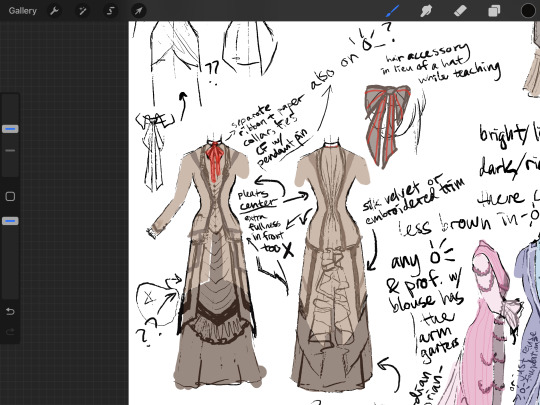
the dominating collar scheme for all the daywear options is brown, and while i could have used more red in accordance with the canon red tie and eyes, i again know that my wardrobe doesnt do red, so that wasnt really a choice in terms of the main body of the dresses if i want to be able to wear any of it normally. This one also needs to have the color layer updated. For the professor outfit, I was keeping in mind a relatively simple/modest design- for a noble lady- but especially in the back where male students would probably see a lot of (since she would be also writing on the blackboard), because anything too complicated or eye-catching could be "distracting". i didnt want to make it too modest because the students and coworkers are also of similar social class to f!william, so there is some expectation of dressing well for her station but also not being too distracting for the young male students :/ i'm still considering toning the design down more, but im not sure how....
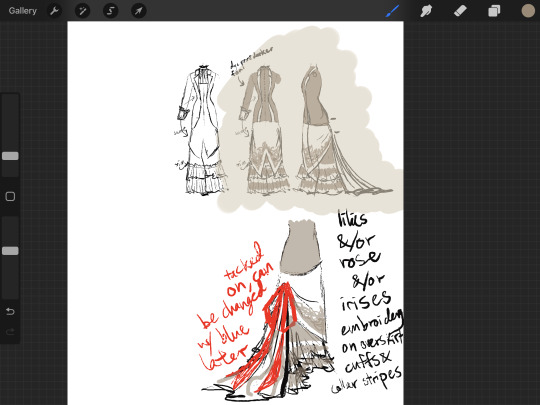
this is what i have for the normal noble lady daywear, hopefully appropriate year-round because i dont feel like designing a new outfit for like all 4 seasons. since it was by far more fashionable for women to wear brighter/lighter colors (usually more adorned by trims in matching/accenting solids rather than patterns for any time of year) during this time if it wasn't winter, in which case it would be dark but still rich colors, i made the browns a lot lighter to compensate for the fact that i'm trying to a. keep close to canon design and b. again, i want to be willing to actually wear it normally, so no reds or pinks as a main part. the big red ribbon will just be tacked on lightly so i can take it off when i'm not cosplaying. I also try to incorporate more of the pressed pleats trims as a nod to william's whole thing about perfectionism, precision, and preparation, as well as him being a math nerd, but like that also ties into the... 3 P's?? so *shrugs*. I also just love the trains of the natural form era so of course I had to add that here, where i can go wildly unpractical, in comparison to the professor one, which does have to account for a good bit of walking by foot across campus and possibly through town. this is also subject to change, but i like to think it's mostly set in stone here.
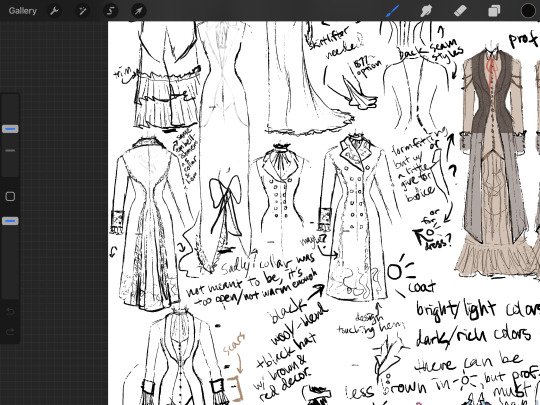
i also designed a black coat as a noblewoman adaptation of the one william wears in canon, which you can see him wearing when he and albert are at adam whitely's park opening speech. I'm not entirely sure about the exact nature and design of the embellishments, but its probably going to be some amalgamation of beadwork and embroidery. i'm actually also going to be making this, straight up because i want a black coat anyways lol. too bad it's not in time for this years winter. i didnt actually draw out the design for the hat but i was planning on a black base hat with brown and red decorations to tie it to any of the daywear clothes, including the coat, and maybe with a sheer white veil in the back? that was in fashion like during at least the mid 1870's. I'm also adapting the cane to an umbrella/parasol. while it'd make more sense to be a delicate litle parasol, i already have a normal-sized black umbrella with a silver metal handle, so that's like a perfect prop that mimics the dark wood cane with a metal handle that william uses in canon, though my umbrella doesn't have a sword hidden in it haha.
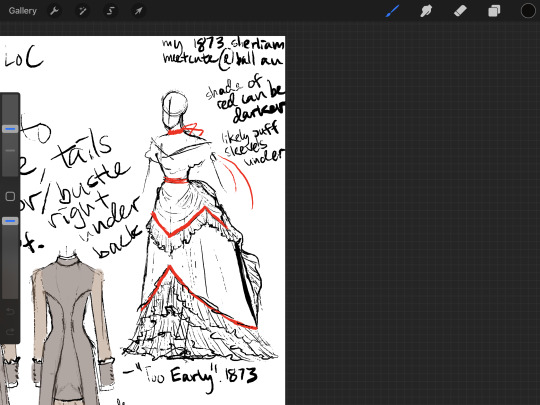
also, as a fun aside, in 1873, there was a brief trend for women to wear a ribbon choker that tied in the back with long tails as an evening wear accessory. so this is a sketch of a painting's outfit, dont remember the name though, that was painted in that year. Correction, I just saw that I wrote it down and its name is “Too Early”. I couldn't help but think up a fun little au of an au where f!william, who would be 18 y/o publicly-known-as-20 y/o, was at a ball and sherlock, male or female? (though i think a female sherlock would be kind of weird considering his canon bias that women are emotional, not as logically intelligent, and delicate :/), was also dragged there by mycroft or something when he decided?? to briefly visit england instead of presumably??? staying at whatever college he was studying at in paris. So, i was originally thinking that it would be such a cool image of sherlock lightly grabbing the tail ends of a red ribbon choker that f!william was wearing with a similar vibe as that sherliam manga vol. 14 cover art, as william turns to look over her shoulder at sherlock. But then, i obviously had to justify it to myself, so i came up with the whole above scenario and i guess they ended up meeting and becoming interested in each other a la canon but earlier and at some point in the night, william was teasingly staying (physically) one step ahead of sherlock and the image is when sherlock finally managed to catch william.
so i guess i'll post updates as i go? i'm definitely estimating this to be a year(s)-long project, considering all the research, patterning, and sewing i'll be doing. i'm also planning on doing a photoshoot with the cosplay when i'm done, so i'll be posting those whenever i have them ready.
edit: I just briefly skimmed a little of the history of female scholars, and apparently the first one to become a professor during the Victorian era is credited to Edith Morley, in 1908 at the age of 33, though there were some other women who also attended a male-dominated college around the same time as her in the 1890’s. Thus, for f!william to have been able to get that professorship or even attend and graduate from a college with a proper degree ~1869-1873, that would have been seen as even more extremely radical, which would have made her stick out in high society in a way that would make it harder to convince targets like lord Enders that she was similarly elitist and a “proper” noblewoman. She also would have had to convince both count Rockwell, her guardian, and the college itself to allow her to attend at ~14 y/o publicly-known-as-16 y/o and maybe even graduate with a proper degree, probably through a lot of machinations on her part, not to even mention being a professor. The only advantage to be found is that she’s seen as a noble, so there is some influence to exert to match male-dominated college chairs.
9 notes
·
View notes
Text

i always like to imagine that these are all related to each other so now i want to see what hilarious extant garments from the 1880s tungler wants to show me
#eddie.txt#my guess is that it would be something from a costume ball#or something to do with an advertisement spectacle
0 notes
Note
Thank you for posting a review on the book Evolution & Revolution Chinese Dress 1700s - 1990s. It’s so disappointing how the book potentially could’ve been good. What are your favorite books on Chinese fashion history?
Hi, great that you found the review useful! To be completely honest, I haven't really read any books on Chinese fashion before I started this blog, because I mostly used online resources like museums' websites, archaeology reports and other blogs. I actually started this blog in the hopes that people might recommend me some books😅 And I only ever read about the Ming, Qing and republican era so my knowledge is very limited.
Anyway, here are some books people recommended to me that I found great, some that I'm currently reading and some I know to be objectively good:
Ming Dynasty
Q版大明衣冠图志 (2011) 董进著
A classic made by the popular fashion history blogger 撷芳主人 (real name Dong Jin), this book is the ultimate compilation of Ming Dynasty looks illustrated by the most adorable drawings. It has basically everything you need to know about Ming Dynasty garments from informal civilian fashion and theater costumes to the most formal court dress and military uniforms. My only quibble with this book is that it doesn’t specify the decade/year each look is from, giving the false impression that everything could be worn throughout the Ming Dynasty (I heard that he did specify some eras in the new version? I don’t have it so I’m not sure). You can follow the author on Weibo where he regularly posts stuff about the Ming Dynasty, or check out other books and articles written by him. Even if you don’t have the book, you could probably find images of individual entries on the internet. Unfortunately all of it is in Chinese and no English version is available :(
华夏衣冠 中国古代服饰文化 (2016) 孙机著
More of a collection of essays Sun Ji wrote on historical Chinese clothing from a variety of eras, I got it for the chapters on Ming Dynasty xiapei 霞帔 and headwear. Professional, academic language that is still easy to read, plenty of references and neatly traced line drawings of artifacts. Useful diagrams on the structure of 狄髻 diji. However if I remember correctly, Sun had some beef with Dong Jin on the terminology of parts of diji, not sure if that was ever resolved; here’s an article about that. Also only in Chinese (that I know of).
Qing Dynasty
Chinese Reverse Glass Painting 1720-1820 (2020) by Thierry Audric
This is the book form transcript of a dissertation given by the author in 2016. It's more Chinese painting than Chinese fashion but has a lot of wonderful images of 18th century export paintings (with dates even), which depicted fashion realistically. I love 18th century export art in general, they're really beautiful and unusual so I would recommend everybody to check them out. I love this because Chinese oil painting outside of a court context (and all other forms of art that were not literati painting e.g. woodblock print, lithograph, pen and ink illustration) gets very little attention from Chinese art historians. This book could be downloaded for free in pdf form the publisher Peter Lang.
A Fashionable Century: Textile Artistry and Commerce in the Late Qing (2020) by Rachel Silberstein
This book focuses on the 19th century and has some interesting insights on the impact of commercial workshops on Qing fashion, which is a welcome break from the “dragon robes” and women’s domestic work stereotyped in most literature on the Qing. It has rich descriptions of the decoration patterns and fabrics used in the 19th century, accompanied by paintings and photographs. It did kind of fall into the trap of “the late Ming continued into the early Qing” and just dismissed the 18th century altogether, which is a shame. Silberstein’s dating of several prints also appears somewhat incorrect, but it’s still a very useful analysis of the 19th century nonetheless. I read this for free on JSTOR through my university login.
Cinderella’s Sisters: A Revisionist History of Footbinding (2005) by Dorothy Ko
This book is absolutely epic and an undeniable classic on the subject. Ko masterfully avoids all the surface level problematic takes on footbinding and offers an extremely nuanced, extremely well researched overview on the history of footbinding in the Ming, Qing and republican eras, the reasons for its popularity and demise, with a most interesting analysis of the problems with the way people in the republican era went about the abolition of it. The book is more heavy on the social analysis side but also contains a lot of factual description of the process of footbinding, styles popular in different eras etc. I just love how she approaches the topic in the most factual and non-emotionally charged way possible, which is refreshing considering the sheer volume of literature on footbinding that is just brainless condemnation without any nuance, a lot of which also unconsciously perpetuate misogynistic ideas rather than combat them. I don’t know of a way to read this for free, I bought it from Amazon.
Every Step a Lotus (2001) by Dorothy Ko
I haven’t read this yet but apparently it works well as a supplement to Cinderella’s Sisters. Also on footbinding.
China Trade Painting 1750s to 1880s (2014) by Jack S C Lee / 中国外销画 1750s - 1880s 李世庄著
Another book on export art, focusing more on the established painters. Lee digs a bit more into the painters’ experiences and biographies, with big portions on George Chinnery and Lam Qua, but also includes plenty of portraits and scenery paintings depicting men’s clothing and the architecture of the studios at the Guangzhou factories (十三行). It’s great because the paintings included were super realistic and well made with accurate proportions and anatomy----the quality on a par with those produced by the European academies----so they contemplate conventional Chinese portraits made in the same era in showing how the clothing fits on the body. Again I bought this book second hand from Amazon.
----
I don’t know of any reliable books for republican era fashion because for some reasons most discourse on it is centered around the glorification and mystification of the cheongsam... Fortunately, due to the abundance of extant originals and photographs, books are largely not necessary for the research of republican era fashion :3
There are some other books and articles that were recommended to me but I haven’t yet read: x, x
@fouryearsofshades also made a post recently recommending books and it covers other time periods as well.
If anyone knows any other books on the Ming, Qing or republican era please tell me regardless of good or bad. I need to read more😅
#book review#historic fashion#chinese fashion#fashion history#vintage fashion#chinese history#ming dynasty#qing dynasty#hanfu#清汉女装#book rec#chinese painting#foot binding
284 notes
·
View notes
Text
Historical Accuracy of Costumes in Period Films - Enola Holmes
Disclaimer: I will put no spoilers so you can still read if you haven't seen the movie yet! This post is just me assessing the costumes and their historical accuracy.
First of all, since the movie came out I had already heard a lot about it in just those two days that I was very curious to see if it lived up to the hype and it truly did! It's well-made with round characters and a gripping story line. But enough about the movie, let's get on to the costumes.
The movie is set in 1884, and at first I thought she was born in 84 (because of the intro) so I did like a third of the movie thinking the costumes were outdated until I looked at a closeup of a newspaper and realized that it is set in 84, so yay for me. But anyways, here are the facts.
Enola is 16 years old, therefore considered a child/young woman in society and would be wearing children's clothing but we'll get to that later
There aren't many examples of children's clothing from that time so I'll have to refer to the few fashion plates that I can find.

This blue dress from the beginning of the film has basically everything one would expect from the very end of the 19th century, but not necessarily the 1880s. The loose front is a very end-of-the-century, more so even Edwardian thing, and from the fashion plates and magazines I could find it seems that children's clothing was heavily inspired by adult fashion. It has a very low waistline and is overall very straight. Enola's dress looks more 1900 except for the fitted sleeves which are accurate for the period. And the collar looks completely out of place. But, of course there’s always a but, this is just taking mainstream fashion into account. The Aesthetic Dress movement took place in the 1880s and the dresses would have looked somewhat similar to this one, with a loosely fitted front but they also had puffier sleeves, so it’s like they took some details from different movements and also took some inspiration from the Edwardians and put them all together in a dress.
Another thing I would like to add, (hence the advert - I had to make collages to fit 10 pictures in this post) I am not sure as it doesn't fit her character at all but she looks corseted in those pictures (I added the first one specifically because I think you're able to see the outline of a corset? Faintly?). Depending on your age and status and your parents' plans for you (aka if they wanted you to get married at 16), teens of that age would either wear a corset or not. But taking Enola's upbringing into account and it was rather uncommon for a 16 year old to be wearing a corset, not unseen but uncommon, I'd say that if the costume department decided to put Millie in a corset in that particular scene is historically inaccurate. There were corsets for young women/teens, but they didn't give you that extreme hourglass shape, they were straighter and didn't give you a tiny waist, like the bottom right one in this corset advert. Unfortunately, I could not find out when it's from but it should be somewhat close to the 1880s.
Next up, I would like to say that the length of the skirt they chose for Millie to wear is appropriate for a 16 year old! Unlike what we saw on Anne with an E...

At one point we get a look at her undergarments and they're looking fine for the time! The chemise and the drawers, she's obviously not wearing any petticoats as she's being measured but we saw a glimpse of a petticoat when she was riding a bike in an earlier scene so yes, this part is accurate.

Next up, I'd like to talk about this lady and her dress is just amazing, fashion plate worthy and absolutely accurate, I have nothing bad to say about this.

What I noticed overall in the movie was that the bustles weren't as extreme as I would have expected them to be, but it all had to do with personal preference so it's not necessarily historically inaccurate to see more lowkey bustles. But I didn't see one bustle that was just crazy in today's eyes so maybe they could have improved on that but I'm just nitpicking at this point. Or maybe I've just gotten so used to seeing old clothes that nothing shocks me anymore.
Here we can see some crinolines being sold and judging from their width they are somewhat outdated.

They could pass as maybe early 1870s if not even 1860s.
Now Enola wants to become a lady, so she has to wear adult clothes! Here, she goes into a shop and puts on her clothing. We can see here how poorly fitted the corset is; the lacing gap should be parallel but you can see in the mirror how it gets smaller towards the bottom. Maybe it was done unintentionally but maybe it's just supposed to show that ready-to-wear corsets just weren't made for the person buying them. But in that same scene, we finally get a proper bustle! That's historical accuracy right there!

Next up is her iconic red gown.

Now... I had a little bit of trouble with that one. The skirt is a little wide in my eyes, but the overall shape and cut is fine, with that layer draping over her underskirt. However, her neckline is something you wouldn't typically see. You see other characters wear high necklines, so I don't know why they chose to give this dress almost an evening wear look. V-necks did exist in evening wear, but then again they would be paired with frilly short sleeves and not tight fitting day wear sleeves. So all in all, yes, the dress is accurate but the neckline is uncommon.
Next, we have what is probably the most accurate one of her costumes – the mourning gown.
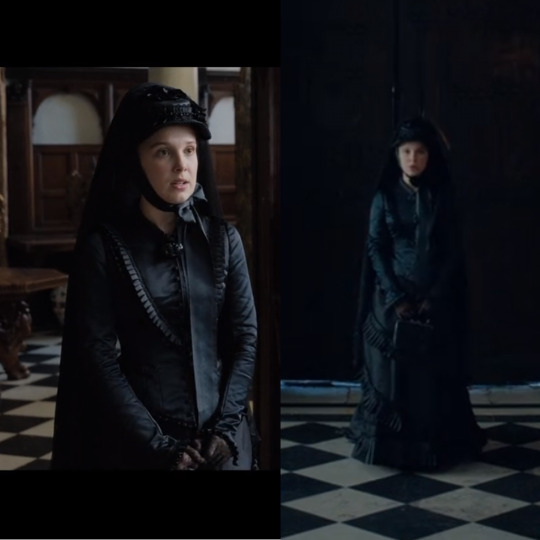
It's slimmer than the red one and there are so many examples of extant garments on google pictures that look so similar to hers that I'm just gonna say, excellent job!
Next is my favorite despite the neckline problem. She just looks so pretty in it!

The neckline isn't as low as on the red one but still quite uncommon. Another detail you can see in the second picture is that she seems to be wearing a bum pad instead of a bustle, which I think is acceptable. It's slim, it has a layer that drapes over the underskirt in the front, and even the sleeves are a little bit gathered at the top which was very common.
And lastly, we have this white dress where she goes back to the style she wore at the beginning of the movie.
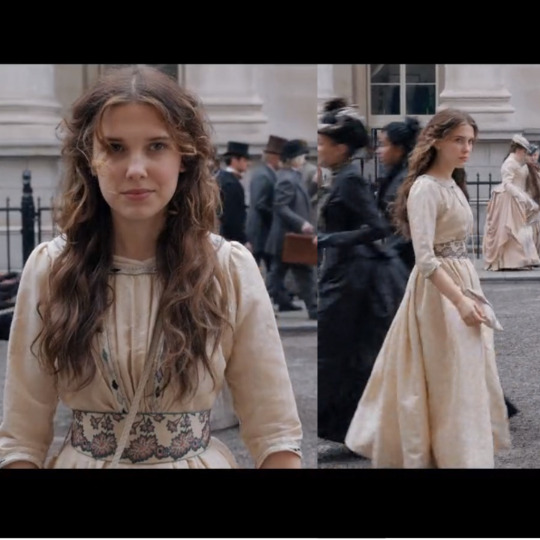
And once again, just like I said in the beginning, this is not something you’d really see being worn in that time unless we’re talking about the Aesthetic Dress and now the sleeves aren’t as fitted so it makes sense for the movement, plus it’s kept very simple.
Overall you can say they did a fairly good job at making everything historically accurate but took some artistic liberties here and there, just like you would expect from a movie.
#enola holmes#sherlock holmes#millie bobby brown#victorian fashion#fashion history#historical fashion#period movies#enola#1880#19th century#1880s fashion#corset#fashion#victorian
1K notes
·
View notes
Text
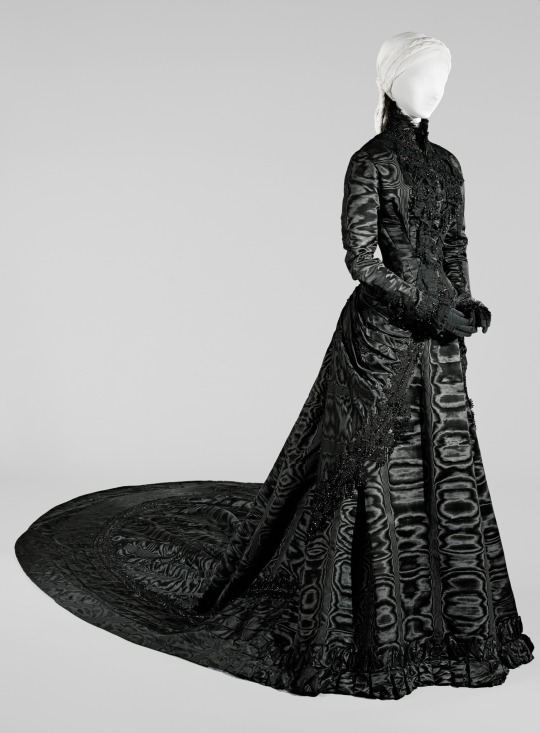

Black Moire Silk Court Dress with Jet Beads, ca. 1885, Austrian.
Worn by Empress Elisabeth ‘Sissi’ of Austria.
Kunst Historisches Museum Wien.
#empress sissi#kunsthistorisches museum#womenswear#extant garments#dress#19th century#austria#1885#1880s#1880s extant garment#1880s dress#black#1880s austria#empress elisabeth of austria#Kunst Historisches museum Wien#khmw
1K notes
·
View notes
Photo
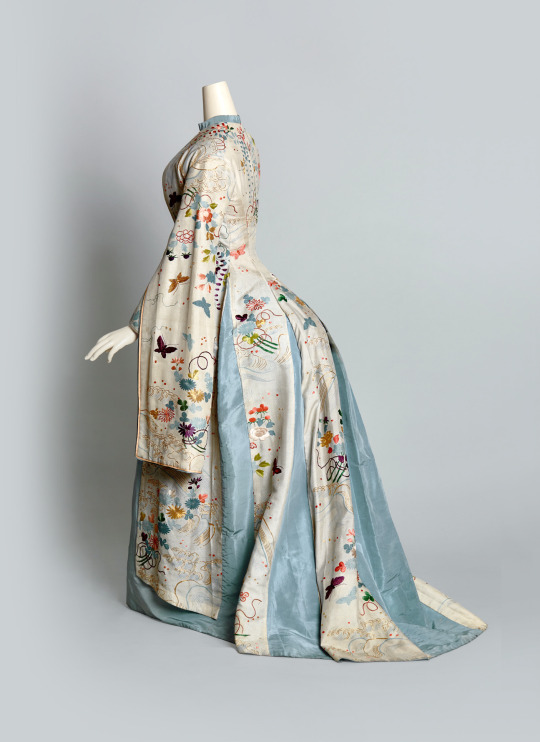

Tea gown ca. 1875-80
From Cora Ginsburg
9K notes
·
View notes
Photo


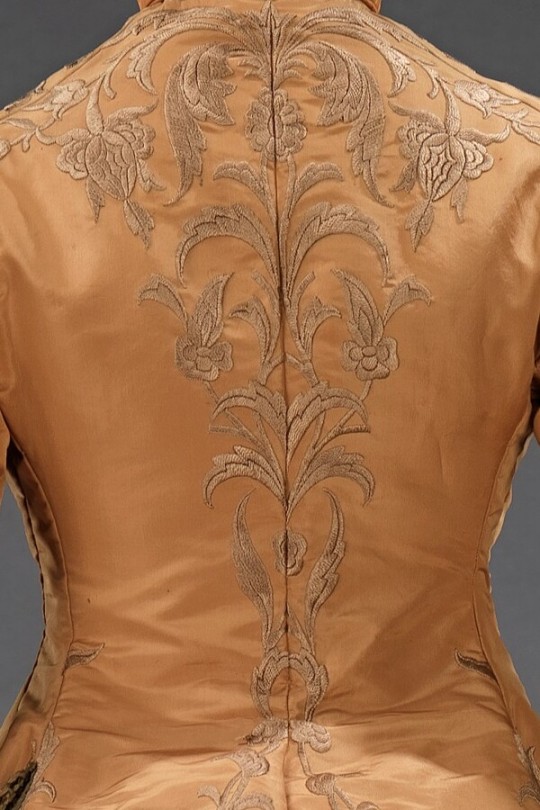
Afternoon Dress
1874
United States
This dress was made from a paper pattern bought in Paris in 1874. Extant garments created from the early days of this type of garment are rarely identifiable. Sized paper patterns were introduced by Ebenezer Butterick (1826-1903) in 1863 and quickly spread to many different companies across the United States and Europe. Being able to create stylish garments at home by sewing machine (which was invented in 1790 but wasn't affordable until the 1850s) revolutionized fashionable dress for the masses. This particular dress has distinctive features of its period such as heavy trim and decorative pockets.
The bustle silhouette, although primarily associated with the second half of the 19th century, originated in earlier fashions as a simple bump at the back of the dress, such as with late 17th-early 18th century mantuas and late 18th- early 19th century Empire dresses. The full-blown bustle silhouette had its first Victorian appearance in the late 1860s, which started as fullness in skirts moving to the back of the dress. This fullness was drawn up in ties for walking that created a fashionable puff. This trendsetting puff expanded and was then built up with supports from a variety of different things such as horsehair, metal hoops and down. Styles of this period were often taken from historical inspiration and covered in various types of trim and lace. Accessories were petite and allowed for the focus on the large elaborate gowns. Around 1874, the style altered and the skirts began to hug the thighs in the front while the bustle at the back was reduced to a natural flow from the waist to the train. This period was marked by darker colors, asymmetrical drapery, oversize accessories and elongated forms created by full-length coats. Near the beginning of the 1880s the trends altered once again to include the bustle, this time it would reach its maximum potential with some skirts having the appearance of a full shelf at the back. The dense textiles preferred were covered in trimming, beadwork, puffs and bows to visually elevate them further. The feminine silhouette continued like this through 1889 before the skirts began to reduce and make way for the S-curve silhouette.
The MET (Accession Number: 2009.300.777a–c)
#afternoon dress#fashion history#historical fashion#1870s#bustle era#gilded age#19th century#united states#1874#brown#silk#embroidery#up close#the met
272 notes
·
View notes
Note
Hello, I hope you are well? For me you are by far the best historical cc-creator for Sims 4. What I really like about your cc is that you pay a lot of attention to detail and your clothes are always historically accurate (inspired by fashion plates for example) which is really rare in this community. Your're creations are also very unique and one can see you have really made them yourself. I am a history student and really love the styles from the past, especially the 1880s-to early 1920s.
For some reason tumblr decided not to notify me of this message, so sorry for the late answer. And thank you so much! That’s one of the loveliest comments I’ve ever received. You totally made my day dear <3
Just one thing I feel obliged to write: historical accuracy is way more common amongst historical simmers than one might think at the first glance. I was surprised to learn how many people style their creations after rl pieces: either fashion plates, paintings or extant garments... And many of them know a hell lot more about fashion history than myself. It’s just that I’m probably the only one putting those inspiration pictures in my previews, so it’s more apparent in my case ;).
19 notes
·
View notes
Text
Women’s Outdoor Apparel: In Historical Context
If I had the opportunity to conduct a research project with unlimited funds, I would do it on the history of women’s outdoor gear. Historical Fashion has always fascinated me, and in recent years my attention has been drawn to the severe gaps that remain in outdoor gear and apparel aimed toward women. For instance, there is an ongoing joke between my friends and I (that has proved true many a time) that all financially accessible women’s outdoor apparel companies only make outdoor wear in the colours black, fuchsia, or teal. Historically, women’s active and outdoors wear has always been a few steps behind that of men.
For example, in 1943 most male sports players were fighting overseas in World War 2, and Philip Wrigley formed the All-American Girls Professional Baseball team, on which the players wore a one-piece skirted uniform as opposed to pants. Women were meant to “look like ladies, but play like gentlemen” (Porter, 2020). From my 11 years playing Softball, I can tell you that sliding into home with anything less than full length pants and sliding pads will leave you with some very unladylike scars.
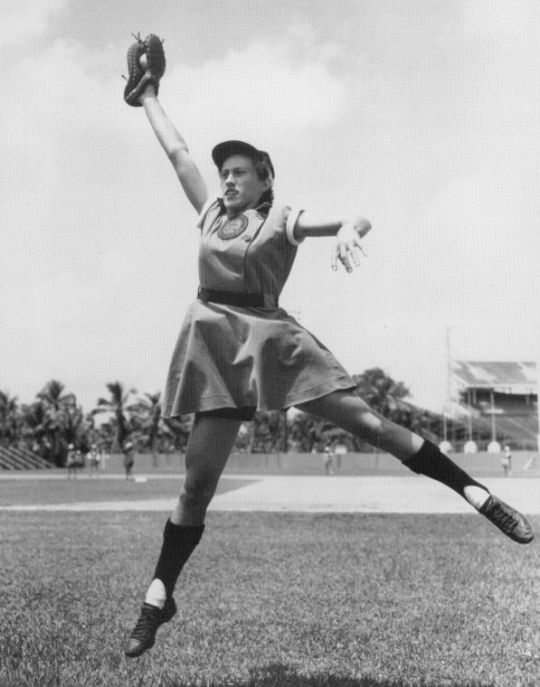
Dorothy “Dottie” Kamenshek, First Basemen for the Rockford Peaches jumping to catch a ball in her uniform, from the National Baseball Hall of Fame, from: https://www.enidnews.com/news/league-of-their-own-women-baseball-players-together-again/article_aa96deac-d474-5e3e-8fa6-9443f239aa89.html
In another example, the 19th century and industrial revolution led to much more expendable income in families and led to more women joining their husbands in outdoor pursuits like yachting and mountain climbing. MacIntosh rubberized-cotton raincoats were patented in 1823 and became quite popular in 1830 following their roll-out to military men, but the popularization of waterproof outerwear for women and subsequent design of fashionable styles would not come until the 1880s and 1890s (Shepard, 2012).
If I had unlimited resources, I would do a deep dive into the history of women’s outdoor wear from woolen shawls and tunics to Helly Hansen Jackets, complete with trips to fashion museums to view extant garments, conversations with historians and modern garment makers, and a look into why so many gaps between men’s and women’s outdoor wear exists.
Ethically, this project would ideally not be a large undertaking. It would focus mainly on compiling existent research and speaking with experts only on the basis of their past research and findings, so factors like engagement with vulnerable persons, power imbalances, and most risk factors would likely be easier to avoid. However, there is always economic and social risks to these experts should they speak ill of their institutions or design companies, so this would need to be addressed. Of course, free and informed consent is also a factor in these interviews, as is respecting participant privacy.
This research would be proposed as a way to help outdoor gear and apparel companies better connect to the wants and needs of outdoorswomen, and as a way to bridge the gap between fashion design and user practicality. It would help gear companies and women by furthering the conversation around past and current inequities between men’s and women’s ability to access the outdoors. It would help expedition leaders and companies in better addressing the gear needs of women who enter their programs.
Reference List:
Porter, M. (2011, March 27). When women ruled baseball: The AAGPBL. HowTheyPlay. Retrieved January 29, 2022, from https://howtheyplay.com/team-sports/When-Girls-Ruled-Baseball
Shephard, A. J. (2012). Waterproof dress : An exploration of development and design from 1880 through 1895. Clothing and Textiles Research Journal, 30(3). https://doi.org/10.32469/10355/6182
3 notes
·
View notes
Text
I love Kate Hawley (Crimson Peak costume designer) being like "yeah we kept the silhouette accurate but the rest is Artistic Interpretation"
because every Dress History Person I've talked to has been like "no you could show me any of those garments in a museum and tell me they were extant, and I'd 100% believe you"
not that they’re typical or average, because they’re definitely not. but the range of clothing styles, designs, trim, texture, fabric, etc. within a given silhouette has always been fairly broad

(1890s evening cape by Emile Pingat)

(1880s gown by Charles Frederick Worth)

(Fashion plate from La France Elegante, 1879)

(Artistic Reform tea gown by Liberty and Co. 1890s.)
And these are just a few examples. I can’t tell you how many photos I come across that make me think “Huge [Insert CPeak Character Here] Energy” and flip past without saving them.
people underestimate how much humans have always loved unusual and beautiful clothing
#crimson peak#costuming#also a lot of the costume sketches I've seen that were done for the movie are based on specific photos#like there are multiple I looked at and thought 'oh yeah I remember that exact period image!'#there's a photo of Virginia Oldoini that I believe inspired Lucille's overcoat#even though in the photo she's actually holding a shawl around her. there was a costume rendering based on it#that turned the shawl into a coat like the one seen onscreen
445 notes
·
View notes
Note
Hello! I was wondering do you have any posts detailing about the aab ROs appearances? Ooh and what clothes everyone wears?
i went digging and hunting through for these, but i came through for you, anon!!!
description of the og 5
description of the new bbys
tag for aab looks (that i’ve sorely neglected woops)
the clothes are all late victorian/edwardian inspired (to be exact, more or less from around the 1880s to early 1910s, right before the first world war). i haven’t really reblogged/made many posts about fashion in aab, mostly because i’m fairly certain most people are familiar with/have a fairly good idea of what the aesthetic is, and there are a lot of really good english resources and extant garments/photographs to study (◕ω◕✿)
#an absinthian ballad#aab cast#aab aesthetics#i mean i actually have a few posts with clothing inspo for aab but i'm just too lazy to dig through my drafts lol#but yeah i think most ppl have an idea of the S-silhouette and how clothes looked back then#even if they can't name the period it's still a familiar look#and i'm making the bold assumption that most of us here are fans of period dramas lol#Anonymous
7 notes
·
View notes